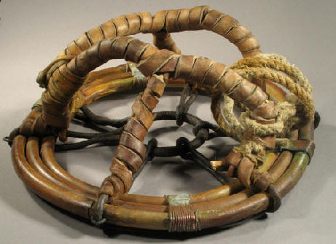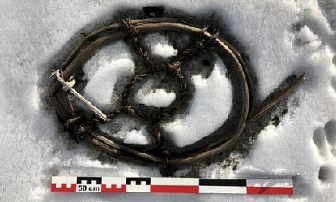Iron-Age equine snow shoe discovered in Norway
|
|
 |
The high mountain pass over Lendbreen in Breheimen, Norway has emerged from melting snow and ice, revealing a treasure trove of artefacts left by travellers who used the route from AD 300 and ending in medieval times around AD 1500. Among the 800 artefacts discovered were horse bones, dung, horseshoes and a “hestetruger”, a snowshoe for horses (left). These effective equine snow shoes, which were highly regarded by generations of horsemen in the Arctic Circle and Canada, played a critical role in Antarctic exploration. Polar Ponies describes how Captain Robert Falcon Scott arrived in Antarctica in 1910. Among his crew were 19 Siberian horses intended to haul the sledges of the Terra Nova Expedition. Scott’s decision to employ horses was based upon the fact that Sir Ernest Shackleton had previously nearly reached the South Pole with the aid of hardy Siberian horses.
Having visited Norway prior to his departure on the Polar journey, Scott saw how hestetrugers had the potential to allow a horse to travel across snow, a fact which would increase his team’s daily mileage. After arriving in Antarctica, on the occasions when the snow shoes had been fitted to his horses, Scott pronounced them a “triumph” and said they were “worth their weight in gold.”
Yet they were not used. This colossal, fatal mishap resulted mainly from the prejudicial decision of the man hired as the horse expert and trainer for the expedition, Captain Lawrence Oates. Ironically, Captain Scott and his four companions might not have died eleven miles from safety on their return trip from the South Pole. At their disposal was the equine key that would probably have enabled them to make it to the Pole and back in 1912 in safety and lived to tell the tale.
When the expedition’s abandoned hestetrugers (right) were re-discovered in Scott’s Antarctic headquarters, English archaeologists no longer recognized what they were or understood the importance of this ancient equine travel tool.

